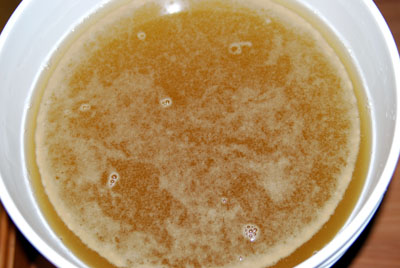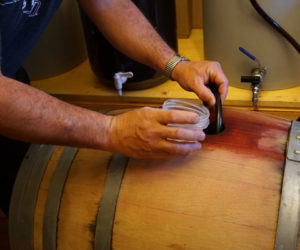Q
I am a wine lover, but unfortunately I have an intolerance to yeast. Is there a yeast-free or low-yeast wine?
John
via email

A
Though I’m no medical doctor (I limit myself to diagnosing and treating troubled wines), I hope I can give you some yeast-related information to discuss with your personal physician. As all wine is created by yeast (that’s the definition of a fermented alcoholic beverage), there’s no such thing as a wine that’s never been touched by yeast. That’s why I’m curious to know what you are truly intolerant of; is it the yeast cells themselves or a byproduct of fermentation? If it is the former, you might be able to tolerate wines that have been sterile filtered, that is, passed through an 0.45 micron membrane before being bottled. The tight pore size of the filter membrane will exclude most yeast cells and keep them from passing into the finished bottle of wine. If you are intolerant of a specific by-product of fermentation like a type of amino acid (too small to be filtered out) I’d have a hard time recommending specific products for you to try unless I knew for sure what the true culprit was.
The good news is that most wines that you can buy off the supermarket shelf don’t contain a lot of yeast cells; if they did, the wines would look cloudy and might even re-ferment in the bottle. Large commercial-scale wineries work hard to ensure that their wines get to market with little or no yeast cells; zero viable cells per bottle is the goal. Commercial white wines, especially those styles that don’t go through a malolactic fermentation (where helpful bacteria eat natural malic acid in grapes and turn it into lactic acid), will almost always be sterile filtered. This is because residual malic acid is a tempting treat for any ambient bacteria that would be abundant in unfiltered wine.
If you are trying to avoid yeast cells in your beverages, you probably should stay away from homemade wine unless you can guarantee that it’s been sterile filtered. I would also avoid homemade Champagne-style wines and beers that have been re-fermented in their serving bottles to get their final fizz. Just because a product can be bought off the shelf doesn’t mean it’s always been sterile filtered, however. Do be careful because some commercial beers, microbrews and, I would suspect, even some commercially available sparkling wines, use the word “unfiltered” as a selling point and could possibly contain hundreds of yeast cells (or none at all) per bottle. Similarly, some commercial wine producers, especially those that make expensive red wines, don’t filter their wines either and they have a higher likelihood of going into the bottle with higher levels of yeast cells than any sterile-filtered wines.
Perhaps the best piece of advice I can give you is to ask the manufacturer and discuss the situation with your doctor. If you live in a wine-producing region you may be able to develop a relationship with a local vintner or two that can give you the details about their production methods. Though I would bet that most nationally-distributed white wines are sterile filtered (due to higher quality filtration techniques available, even many reds are these days), it’s tough to get a hold of those guys to double-check.
I encourage you to discuss my response with your doctor and see if drinking sterile-filtered wines, and therefore ingesting fewer yeast cells, would be allowable in your condition.
Q
I have two 225-liter Limosin French oak barrels filled with a blend of 70% Nebbiolo, 20% Barbera and 10% Merlot that was fermented in October 2005. It is topped off regularly and meta was added twice. It was racked into the barrels after the first ferment but has never been racked since. They are in an old-fashioned root cellar in western Massachusetts and the temperature stays between 35–60 °F (2–16 °C). I am ready to remove the barrels, but I don’t know if the wine has gone bad. Should I rack and return to the barrels for, say, another 35–45 days then rack to glass demijohns or carboys, or can I go right to bottling?
Ted Handerek
via email

A
In deciding to bottle, age or toss this batch, I suggest you spend some quality time with your barrel. Though you’re just past the usual bottling window (typical aging time for premium red wines is 10–18 months, depending on the varietal and style) you may be able to catch it before it goes south. Especially if the wine has been well taken care of, topped regularly and sulfite added along the way, you should be fine. Though it sounds like you’ve been perhaps a little neglectful in your racking and sulfur regimen, you may be pleasantly surprised. Some wines do best when we walk away and let them do their own thing.
Thief yourself a little bit out of the barrel into a clean glass and go out into the sunlight. Give it a few good swirls and stick your nose in the glass. Do you like the way it smells? Does it still have some perceptible fruit? Is the wine free of oxidized and other aroma defects? Smells like Port, Sherry and nail polish can all be signs of spoilage. Because it’s only been racked once, I would watch out for aromas like burnt rubber, onion, or rotten eggs. Though rare for a wine at this age, there are some stinky compounds like mercaptans and sulfides that can live in deep in layers of undisturbed lees and infect an entire barrel. Since you’ve only racked once, you could be at risk.
Then take a look at the wine (inclining the glass over a sheet of white paper can help). Is the wine clear? Is the color still holding up? Though Nebbiolo can lend itself to age more into a brick red/garnet color spectrum, the color should at least be red still with maybe a little brick red around the edges. Last but not least, give it a taste. If it’s pleasant to you, there’s no reason not to bottle it. It probably doesn’t have monstrous tannins but you could always try egg white fining or a similar gentle fining method to smooth out any rough edges you may find.







